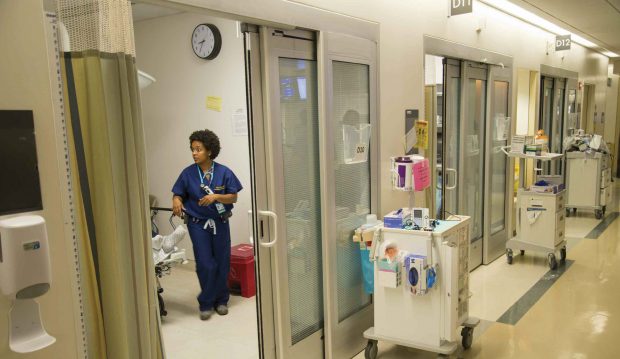
Kara Toles ’07 makes her morning rounds in the D-Pod.
6 a.m.
At this hour, as at every hour, the D-Pod bustles beneath the round-the-clock glow of the hallway strip-lights. Attending physician Kara Toles ’07 has just begun her shift in the Emergency Department of the UC Davis Medical Center (UCDMC), and for the moment, both the outgoing and incoming teams are jammed together inside the tiny, walk-through office known as the “Doc Box,” a space about the size of a janitor’s closet. As they work their way through the customary hand-off, their terse exchanges are studded with terms like “angioedema” and “metabolic encephalopathy.” Toles quickly takes charge, quizzing the three young residents and one visiting medical student who will make up her team for the day.
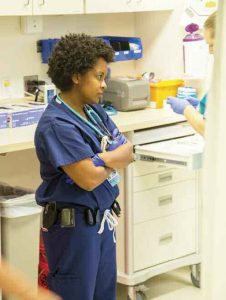
Toles observes preparations in a trauma room.
Once the hand-off is complete, Toles loses no time in setting out for her first tour of the surrounding hallways. As she speed-walks, print-out in hand, she pokes her head through each set of curtains to introduce herself, greeting each patient by name. The important thing, she explains, is to get a firsthand sense of which patients can wait and which need immediate care. “The first thing we’re trained to do with a patient is say, ‘What do I see, hear and smell? In medicine, and especially in emergency medicine, we have to use all of our senses, picking up cues. Just standing outside of a room, you can tell a lot about a person’s airway, breathing and circulation—the ABCs—just from looking at them.”
Today, most of the cases seem to be fairly routine, but one catches her eye—a man suffering from a severely swollen lip and chin. She speaks with him for a few minutes before moving on. “That can go downhill really fast,” she remarks as she hurries back to the Doc Box. “We need to take it very seriously.”
Welcome to the D-Pod. That’s D as in disease, disaster and death. It’s what they call the section of the ER that handles the patients Toles describes as “really sick”—that is, dealing with potentially life-threatening conditions. Today, their immediate welfare and, possibly, their ultimate survival will depend on how well Toles and her team do their jobs.
THERE’S A CERTAIN irony in Toles’s decision to specialize in emergency medicine. Back in 2005, as a junior at Pomona, struggling with the academic workload of a premed student and trying to decide what major to pursue as she followed her childhood dream of becoming a doctor, she was featured in an article in this magazine titled “Stressed,” in which she opened up about the difficulty of dealing with the unrelenting demands of college life. Her first year was so stressful, she said at the time, that “I’m sure I would have transferred if it were not for the support that I got through my sponsors and other peers in my sponsor group.”
Fast-forward—past graduation, past a year off to regroup, past four years of medical school at UC Davis and various rotations as a resident—to her choice of arguably the most stressful of all medical specialties.
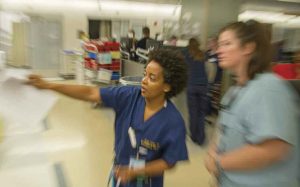
Toles makes a teaching point with medical student Samantha Kerns.
“I know,” Toles says with a laugh when reminded of that history. “What does that tell me about myself? I guess I thrive in stressful environments? I feel alive in stressful environments? It’s that degree of stress that makes you get up and do, and not feel paralyzed. And I think that I need some degree of that to feel alive. But then, my baseline is to back off and say, ‘Hoo, all right. I’m going to chill now.’ But every once in a while, I need it to remind myself that I’m alive.”
That balancing act seems to be a lifelong pattern. At Pomona, for instance, she solved her early battle with stress, in part, by choosing a less traditional path into medical school, switching her major from neuroscience to Black Studies because it allowed her to break away from the sciences and spend more time exploring her identity as a Black, queer woman and how to incorporate social justice into her practice as a physician.
“I was able to tap into those other sorts of courses—psychology and art history and music and dance, West African dance, and history of jazz with Bobby Bradford and all these super-cool classes that I wouldn’t have had the opportunity to take if I were doing neuroscience. It was really fun to learn about that stuff, and it kind of helped me have a better understanding of who I was as an African American woman, so it was a pretty awesome experience.”
Today, the pattern continues with Toles’s decision to work part time instead of committing to a full-time position in a hospital ER. “Residency was a lot of people telling me where to go, what to do, and when to do it,” she says. “I’m a very headstrong, independent woman, and so I needed that part of my life back after training. I’m taking a little bit of a pay cut because I’m not signing on somewhere and getting, you know, that salary and benefits package. But I only work around eight to 10 shifts a month, so I have a lot of free time to decompress and tap into things that give me life and make me happy and make me feel fulfilled.”
9 a.m.
Toles checks in again on the patient with the swollen lip and is delighted to learn that the swelling is going down. After counseling him on his daily medications, she returns to the Doc Box and wolfs down a beef stick, a few walnuts and some trail mix to keep her energy level up. “You never know when something’s going to go down, so I just snack and then have a full meal after I get off,” she says.
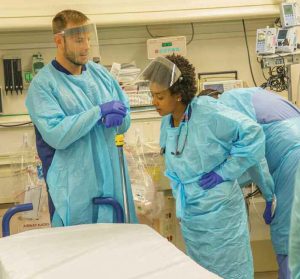
Toles awaits the arrival of a trauma patient with chief resident Taylor Stayton.
With her whole team momentarily present, Toles offers to demonstrate a new technique for resolving a dislocated jaw without having to put fingers inside the patient’s mouth, but as if on cue, events begin to speed up, postponing the demonstration and sending residents scrambling.
First, there’s a new analysis of imaging for a patient suffering from an uncontrollable tic, identifying a potentially deadly subdural hematoma—blood pooling between the skull and the brain. Then a new patient arrives with a badly broken wrist, the result of a skateboard accident. That’s followed by another patient showing troubling signs of gastrointestinal bleeding, and another suffering from weakness in one arm and leg following a traffic accident, and another suffering from a bizarre condition called subcutaneous emphysema, in which air escapes from the lungs into the surrounding tissues, causing strange, crinkly swellings of the chest, throat and face.
In the midst of all that hectic activity, the loudspeaker announces a 911 emergency arriving in five minutes, and Toles and the chief resident drop everything to head for one of the trauma rooms, where they join a growing crowd of attendings, residents, nurses, technicians and students. Pulling disposable plastic gowns over their scrubs and donning gloves and face shields, they join their colleagues inside the red line on the floor that separates participants from observers—and they wait.
A little before 10 a.m., the patient arrives, strapped to a gurney. She’s a disoriented homeless woman with stab wounds to the neck, reportedly self-inflicted. As someone closes the glass doors to the room, she can be heard shouting threats and obscenities at the doctors as they close in to care for her.
IN ADDITION TO broadening her education, Toles’s choice of Black Studies as a major had a significant impact on the kind of doctor she wanted to be. For her major thesis, she studied the relationship between the nation’s medical system and social justice, and the inequities that she saw gave her a new mission in life—caring for people on the margins. That was still on her mind a few years later as she neared the end of her medical training and began to explore specialties.
“At first, I was thinking, ‘How do I marry this idea of social justice and using medicine as a vehicle for social justice?’ And to me, that meant preventive care, and the essence of that is pediatrics, like having conversations with folks about healthy behaviors before they get chronically ill. But then, when I did my peds rotation, I was like, ‘Theoretically, that makes sense, but in practice, I don’t feel engaged, you know? Kids are cute and whatever, but at the end of the day, I’m not excited.’ It just didn’t speak to me. So it was like, ‘Oh bummer. What else am I going to do?’”
The answer came to her, strangely enough, while working up a sweat on a climbing wall.

Toles gets hands-on with a patient in the D-Pod.
“I met an emergency medicine doctor in the climbing gym,” she says with a laugh. “And he was a really cool guy, really nice guy, an awesome climber, and I knew that he was associated with UC Davis but I wasn’t sure how. We ended up kind of being in the same friend group at the gym, and he told me he was an ER doctor, and I was like, ‘You? You are really cool. You’re out there doing things that I want to do, and I want to be like you.’ And he’s like, ‘You totally should check out emergency medicine.’ And I did, and I fell in love with it.”
Part of that love, she says, has to do with the people she sees in the ER. Many are precisely the kind of people on the margins to whom Toles pledged to devote her career.
“That’s what we do in emergency medicine,” she says. “Whoever walks in the door—it doesn’t matter your race, sexual orientation, gender identity, age, whether or not you have a home—we treat everyone, and that’s one of the powerful things that drove me to emergency medicine and that keeps me there.”
Then too, it appealed to her because it reminded her of what she loved most about college.
“Of all the specialties, emergency medicine is the one that has kind of a liberal arts flavor to it because of the breadth of knowledge that’s required to do this practice,” she says. “I love the fact that I get to see such a breadth of pathology. I think it’s incredibly engaging in one minute to be taking care of a patient who has angioedema, which is the swelling of the lips or the mouth that can be life-threatening, and then I walk out of the room and take care of a critically ill, injured trauma patient. So that switching and the dynamic nature of my job, I just love. It keeps me excited. It’s like stuff that you see on TV.”
12 noon
A crackly voice on the public address system announces, “911 in three minutes,” and as the inhabitants of the Doc Box turn to their computer screens for details, the mood abruptly shifts from laid-back to tense. “This sounds real,” the chief resident says.
As Toles and the chief resident head for the trauma room, all they know for sure is that the patient has suffered a traumatic amputation of his lower left arm in a motor vehicle accident, but they know that an accident of such severity is likely to produce other kinds of trauma as well. As they gown up, they discuss their role in the coming procedure, which will be to establish an airway, if needed.
Despite the three-minute warning, they’re still waiting 20 minutes later, as a crowd of observers gathers around the red line in the room and overflows into the hallway.
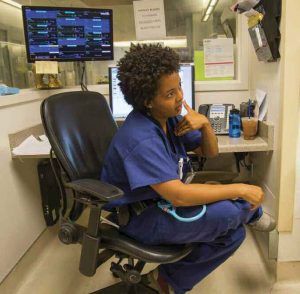
Toles makes a point in the Doc Box.
Finally, EMTs steer a gurney down the long corridor to the trauma room. On it is a male patient in obvious pain. Word spreads that he was driving with his arm outside the window when a guard rail struck him just below the elbow. A few minutes later, two highway patrol officers arrive carrying a cooler. A member of the team removes the severed arm and begins to clean it in hopes of a possible reattachment—an effort that will prove to be in vain.
Later, back in the Doc Box, Toles turns to the residents and asks, for maybe the fourth or fifth time that day, “Okay, what are the learning points from that case?”
“WE CALL IT dropping pearls,” Toles says of the teaching aspect of her job. “Dropping little pearls of knowledge along the way.”
After all, UCDMC is a teaching hospital, and the ER is in many respects a big, high-stakes classroom. The residents and fourth-year students are there to care for patients, but they’re also there to learn through observation and firsthand experience.
“And if they ever get stuck,” Toles adds, “then they know that the attending is there to help them push through that part.”
The chance to gain experience in teaching, she says, is one of her own principal reasons for working here. However, this part-time job at UC Davis is not the only iron Toles has in the fire. She’s also taking shifts back in her hometown of Angleton, Texas, in the ER of the small community hospital where she was born, as well as working in the much tamer environs of an urgent-care center near her home in Oakland.
“‘I have issues with commitment,’ is what I tell the residents,” she says with a laugh. “I don’t like to commit until I know what I’m getting myself into because I like to give 110 percent when I do commit, and I don’t like to give less than that.”
Each setting provides her with a very different taste of life as an emergency physician. “I’m getting a feel for these different settings,” she explains. “So I picked jobs that are in communities that mean a lot to me, that I haven’t been able to engage in the way that I want to because I’ve been in residency. Working here at UC Davis, I get to engage in this community with my friends and learn how to be a teacher at this academic institution. And then, my job down in Texas is in a small community hospital where it’s single coverage, and I’m the only emergency medicine doctor in the Emergency Department, which is a completely different experience.”
Eventually, she expects to make a more permanent career choice, but for now, she’s content with the freedom her unconventional lifestyle provides. “I wanted to get a feel for what it’s like to be a doctor in those many different settings,” she says, “but I’m also tapping into these people in my life that I had to neglect while I was in residency and put energy, love and time back into those relationships, which feels great.”
1:45 p.m.
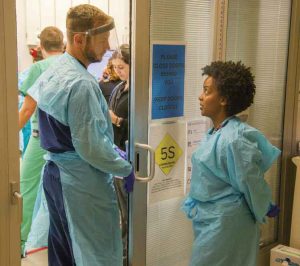
Toles and chief resident Taylor Stayton gown up for a trauma case.
As her shift winds down, Toles goes out for her final rounds. “I want to visualize everyone one more time,” she explains. Then it’s back to the Doc Box for the hand-off to the next crew. Though her shift ends, theoretically, at 2, she hangs around another hour or more to make sure that the transition goes smoothly and, finally, to give her long-delayed demonstration of the new technique for resolving a dislocated jaw.
It’s been a good day by her standards—she’s taken care of some “really sick” patients, but the D-Pod wasn’t so swamped that she had no time to teach. Most importantly, no one died on her watch. That’s one experience in the ER that she prefers not to talk about. When asked about it later on, away from the ER, she quickly changes the subject, but a few minutes after, as she is discussing something else, a tear rolls unexpectedly down her cheek in response to some unspoken memory.
“I try not to have that happen at work,” she says as she swipes it away, “but you’re human. Accidents in young people—those are the worst. But you do what you can medically to try to save them, and if you’re not able to, then it’s heartbreaking. But you honor the life that has passed, and you try to figure out what ways you have to deal with that and cope with that.” She dabs away another stray tear. “If I ever get to the point where I’m not crying when a baby dies, then I need to stop doing my job.”
